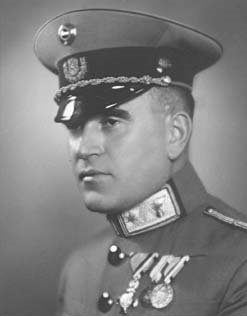Dr. Paul Schmittner

Personalia
Born:
Died:
Profession:
Persecution:
Imprisonment 13.03.1938 - 02.04.1938,
Dachau concentration camp 02.04.1938 - 27.09.1939,
Flossenbürg concentration camp 27.09.1939 - 02.03.1940,
Dachau concentration camp 02.03.1940 - 20.04.1940,
Released 1940, escape 1944,
Resistance fighter (undiscovered)
KZ Number:
Memberships
Curriculum Vitae
After graduating from high school, Paul Schmittner joined the gendarmerie from 1924 to 1926 and completed the Officers' Academy. During this time, he studied law part-time at the University of Vienna, where he also obtained his doctorate in law. In 1930, he became active in the Rudolfina student fraternity. He later joined the gendarmerie in Krems/Danube, where the illegal regional leadership of the NSDAP was based.
Paul Schmittner was arrested and imprisoned as a gendarmerie major and department commander in Krems/Danube immediately after the Anschluss on March 13, 1938. He was one of the prisoners transferred to Dachau concentration camp on April 1, 1938 [Gestapo list: 131] on the so-called 'Prominent Transport'. From there, he was transferred to Flossenbürg concentration camp on September 27, 1939, before being transferred back to Dachau concentration camp on March 2, 1940, from where he was released on April 20, 1940. He was relieved of his post and retired with 50 percent of his pension.
Fearing another arrest, he fled to relatives in Tyrol after the assassination attempt on Adolf Hitler on July 20, 1944. From November 1944, he had contact with resistance groups there and set up an organization. On May 3, 1945, the NSDAP in Ginzling is dissolved and all documents and weapons are confiscated. In addition, "returnees" had to be provided for, and Wehrmacht and SS soldiers passing through were disarmed. A force of 38 men is set up to prevent armed units from entering the Zillertal. On May 8, 1945, the day of the capitulation, a mayor and a provisional municipal council are appointed.
Paul Schmittner rejoins the gendarmerie and is appointed provincial gendarmerie commander of Burgenland in 1945. He retired as a police officer and died at the age of 87. He finds his final resting place at the cemetery in Vienna-Rodaun.
[...]
In particular, he and his men from the resistance movement and the auxiliary police force he had set up:
1, by encircling and disarming the heavily armed group of General Shillenkoff, Wlassoff's deputy, which had already been entrenched behind Mayrhofen, as well as disbanding and disarming a Wehrmacht transport column under the command of a major which had been in Hollenzen,
2, by disbanding, disarming and rendering harmless the NSDAP and its affiliated organizations, as well as through the arrest of prominent representatives of this party and SS people in Mayrhofen and the surrounding area,
3, by carrying out the general disarmament, and in particular the disarmament and smuggling through of more than 18.000 members of the Wehrmacht and Waffen-SS streaming back from the collapsed southern front and the delivery of several carloads of weapons, ammunition and war equipment to the occupation authorities and finally
4, through the constant surveillance of the extensive approx. 800 km2 large and difficult border and high mountain area, defense against attacks by Italian partisan groups and the resulting maintenance of public order, peace and security until the gradual occupation of these areas by the American occupation troops only 4 to 7 weeks later,
the entire southern Zillertal and its population were protected from the impending horrors of war, looting and unrest.
Major Schmittner Dr. has rendered invaluable services to the liberation and pacification of Tyrol and Austria in general and the Zillertal in particular through his planned and purposeful activities, for which the municipality of Mayrhofen expresses its warmest thanks and fullest appreciation.
[...]
After the liberation of Austria and the re-establishment of the Republic, Paul Schmittner rejoins the gendarmerie and is appointed provincial gendarmerie commander of Burgenland in 1945. He retired as a police officer and died at the age of 87. He finds his final resting place at the cemetery in Vienna-Rodaun.
Places
Persecution:
Residence:
Citations
Krause, Peter/Reinelt, Herbert/Schmitt, Helmut (2020): Farbe tragen, Farbe bekennen. Katholische Korporierte in Widerstand und Verfolgung. Teil 2. Kuhl, Manfred (ÖVfStG, Wien) S. 303.
Wiener Stadt- und Landesarchiv (WStLA)
